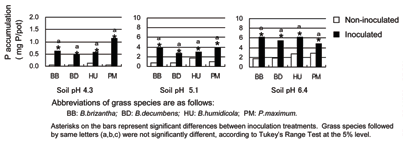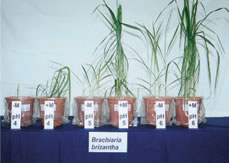Significance of indigenous arbuscular mycorrhizal fungi in forage production in the Brazilian savannas
Description
[Objectives]
Several tropical grasses of Brachiaria species or Panicum species cover 95% of the improved pastures in the Brazilian savannas. Although it is generally known that arbuscular mycorrhiza (AM) fungi enhances adaptability of the grass species to infertile acid soils in the savanna regions, there is little information regarding the effects of indigenous AM fungi on forage production. In this study, the relationship between the grass species, indigenous AM fungi, and soil pH was examined for 4 tropical grass species.
[Results]
Seedlings of Brachiaria decumbens, B. brizantha, B. humidicola, and Panicum maximum were planted in pots filled with an Oxisol collected from a native savanna area in Campo Grande at Mato Grosso do Sul State, Brazil. They were grown in a greenhouse for 70 days with two inoculating treatments (with/without inoculation of the indigenous AM fungi) in combination with three levels of soil pH (4.3, 5.1 and 6.4).
Inoculation of AM fungi increased the shoot and root dry weights in all species (Photo 1). Phosphorus(P) concentration in the shoots and roots as well as total P accumulation in the examined grass species were improved by AM inoculation (Fig. 1). The mycorrhizal effect on P acquisition was larger in B. decumbens and B. brizantha than in P. maximum and B. humidicola. An increase in soil pH had a positive effect on the plant dry weight and P acquisition of the 4 grass species. All grass species showed the highest AM dependency on dry matter production and P accumulation at the lowest pH levels.
In this study, it was discovered that the existence of indigenous AM fungi was necessary for the 4 grass species growing on the Brazilian Oxisol, and that the importance of AM fungi was most significant at the lowest soil pH condition.
Figure, table
-
Fig. 1. P accumulation of four grass species affected by arbuscular mycorrhiza inoculation and soil pH. -
Photo 1. Mycorrhizal (+M) and non-mycorrhizal (-M) Brachiaria brizantha at soil pH levels of 4.3, 5.1 and 6.4.
- Affiliation
-
Japan International Research Center for Agricultural Sciences Animal Production and Grassland Division
-
Brazilian Agricultural Research Corporation
- Classification
-
Technical A
- Term of research
-
FY2001 (FY1997-2001)
- Responsible researcher
-
KANNO Tsutomu ( NARO Institute of Livestock and Grassland Science )
SAITO Masanori ( NARO Institute of Livestock and Grassland Science )
ANDO Yasuo ( Animal Production and Grassland Division )
NAKAMURA Takuji ( Crop Production and Environment Division )
MACEDO Manuel. C. M. ( Brazilian Agricultural Research Corporation )
- ほか
- Publication, etc.
-
T. Kanno, M. J. Borges, M. Saito, M. C. M. Macedo, T. Nakamura and C. B. H. Miranda (2001): Importance of indigenous arbuscular mycorrhiza for dry matter production and phosphorus acquisition in tropical forage grasses. Proceedings of the 28th annual conference of the Brazilian Society of Soil Science, Londrina, Brazil, 80.
- Japanese PDF
-
2001_13_A3_ja.pdf956.57 KB
- English PDF
-
2001_10_A4_en.pdf90.78 KB


